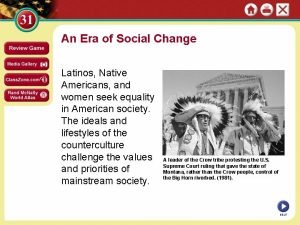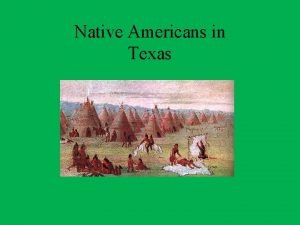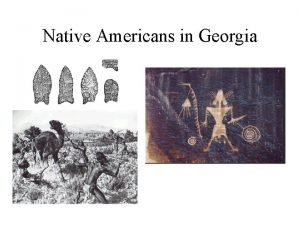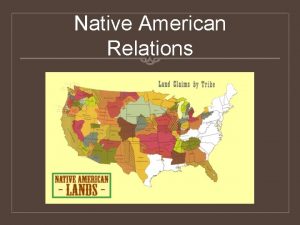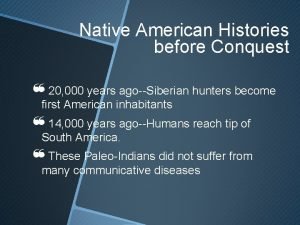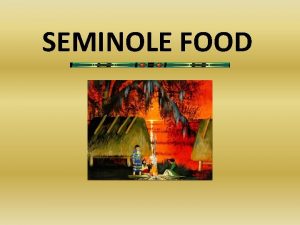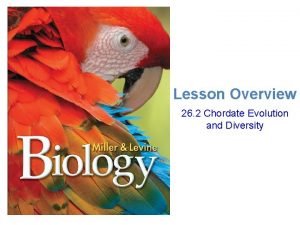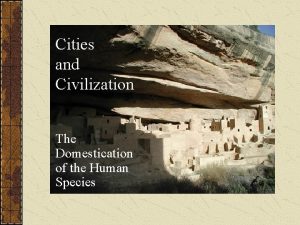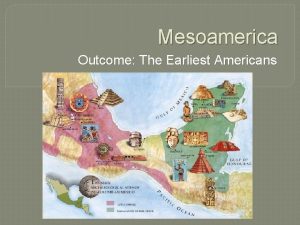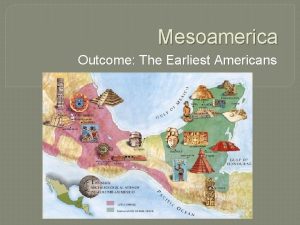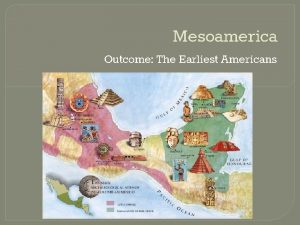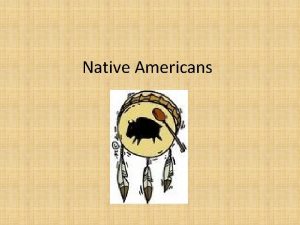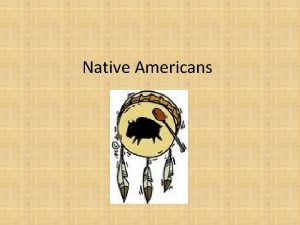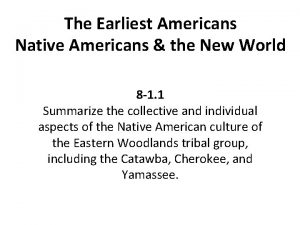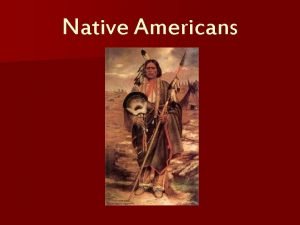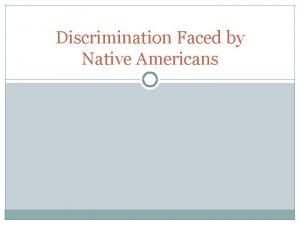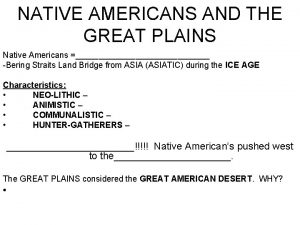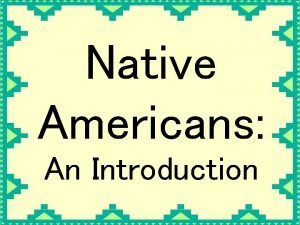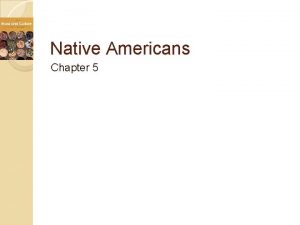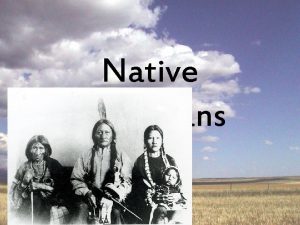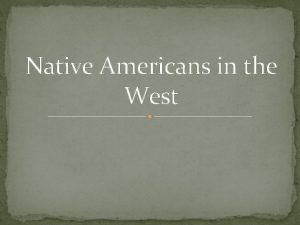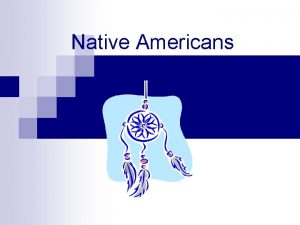The Earliest Americans Native Americans and the New




















- Slides: 20

The Earliest Americans Native Americans and the New World

The Coming of the Native Americans • The first Americans entered the Western Hemisphere across a land bridge from Siberia to Alaska where the Bering Sea is located today. • The first Americans were known as Native Americans. • They formed hundreds of groups, or cultures, and had many different lifestyles.

Bering Land Bridge

Native American Ways of Life They spoke many languages and had many things in common: • Lived close to nature and adapted their life styles to the landscape. • Valued independence and self-confidence. • Native Americans honored one another’s word as a sacred pledge and treaties made between nations were not broken.

Native American Regional Groups • Divided into regional groups based on where they lived and their language they spoke. • One group, the EASTERN WOODLANDS, were the first group to met with European settlers in North America.

Native American Life and Culture • Use of rivers: transportation and fishing. • Used rocks, wood animal pelts to make tools for hunting, farming and clothing. • Housing: made from natural resources like tree bark and animal hides. • Use of land: fertile land was farmed.

Farming • Eastern Woodland native people will settle into permanent villages by farming the land. • “Slash and Burn”: cut trees and burned the brush to create this farmland pasture for animals. • Primary crops were corn, pole beans and squash (known as the 3 sisters!). • Tobacco was also grown.

Roles of Men and Women MEN • Men cleared the land hunted for food. • They fought when necessary. • They trained boys to follow the same role. WOMEN • Planted and harvested crops, gatherers and farmers. Hoes used made of bone. • Cared for children and trained the girls. • Some women even served as chiefs.

Native Americans in South Carolina • The first American Indians came to South Carolina about 13, 000 B. C. • There were 3 major American Indian groups in South Carolina: 1. Cherokee of the mountain region 2. Catawba of the Piedmont region 3. Yemassee of the coastal region

The Cherokee • Powerful group that lived in the foothills and mountains of SC, lived in village type fashion. • In summer they lived out in the fresh air, in winter they made structures out of grass and clay called “daub”, and roofs made of bark and branches called, “wattle”. • Men poisoned the water with walnut bark to fish. • Leaders included women, leaders met as a council of members to make the rules. • In times of war, a “red leader” took control. • In times of peace, a “white leader” took control.

Cherokee Lands in SC

The Catawba Tribe • Called themselves the “people of the river. ” • Lived in the Piedmont region. • Housing was in the form of wigwams, made from bark, grass and reeds. • The council members made the rules. • Known as great potters, used clay to make pots.

The Yemassee • Originally from Spanish Florida but moved along the coast of SC to escape the Spanish people. • In summer they lived near the beach in wigwams. Other times of the year they lived inland in wattle and daub homes. They used palmetto leaves as their roof. • They ruled by council which included women. • This group fled to Florida after their defeat in the Yemassee War with the European settlers.

Native American Land Use • • Used the land for farming and hunting. Hunted using small spear points. Clay and sand was used to make pottery. Pottery was decorated.

Native American Spear Points

Movement of Native Americans • The groups never stayed in one area. • In many cases, groups would leave after wars.

What did the Natives look like? • Travelers during the Colonial period described the natives as: • • Tall, over 6 ft. tall Skin color ranged from olive to dark copper Hair was straight and black or dark brown Often had painted designs on their faces and tattoos on their bodies

Europeans Arrive • Native American life changed greatly when the Europeans began to come to South Carolina • Disease from the arriving Europeans began infecting the natives, and because their immune systems were not able to fight off the new strains of diseases, the Indians began dying by the thousands. • Eastern Woodlands traded furs and deerskins for iron tools, weapons and guns.

Europeans Arrive • As more and more settlers arrived, they cheated the natives with trade, took over their lands, forced some natives into slavery which will lead to hostilities in the future years.

Next: The European Countries that will settle in SC…
 Latinos and native americans seek equality
Latinos and native americans seek equality Coahuiltecan tattoos
Coahuiltecan tattoos Where did native americans come from
Where did native americans come from How many native americans died on the trail of tears
How many native americans died on the trail of tears What three circumstances hurt native american
What three circumstances hurt native american Native americans
Native americans Traditional seminole indian food
Traditional seminole indian food Advantages of linear model of communication
Advantages of linear model of communication Define urban hierarchy
Define urban hierarchy Socio-cultural impacts
Socio-cultural impacts The are our earliest literature
The are our earliest literature The earliest bridges consisted mainly of
The earliest bridges consisted mainly of Prometheus
Prometheus Chordate evolution and diversity
Chordate evolution and diversity Earliest urban hearths
Earliest urban hearths Earliest start time formula
Earliest start time formula This bring the first sorrow of rizal in calamba
This bring the first sorrow of rizal in calamba Pericles and the bull
Pericles and the bull Short history of tennis
Short history of tennis The earliest recorded activities in gymnastics.
The earliest recorded activities in gymnastics. The earliest fossils date back to about when?
The earliest fossils date back to about when?
